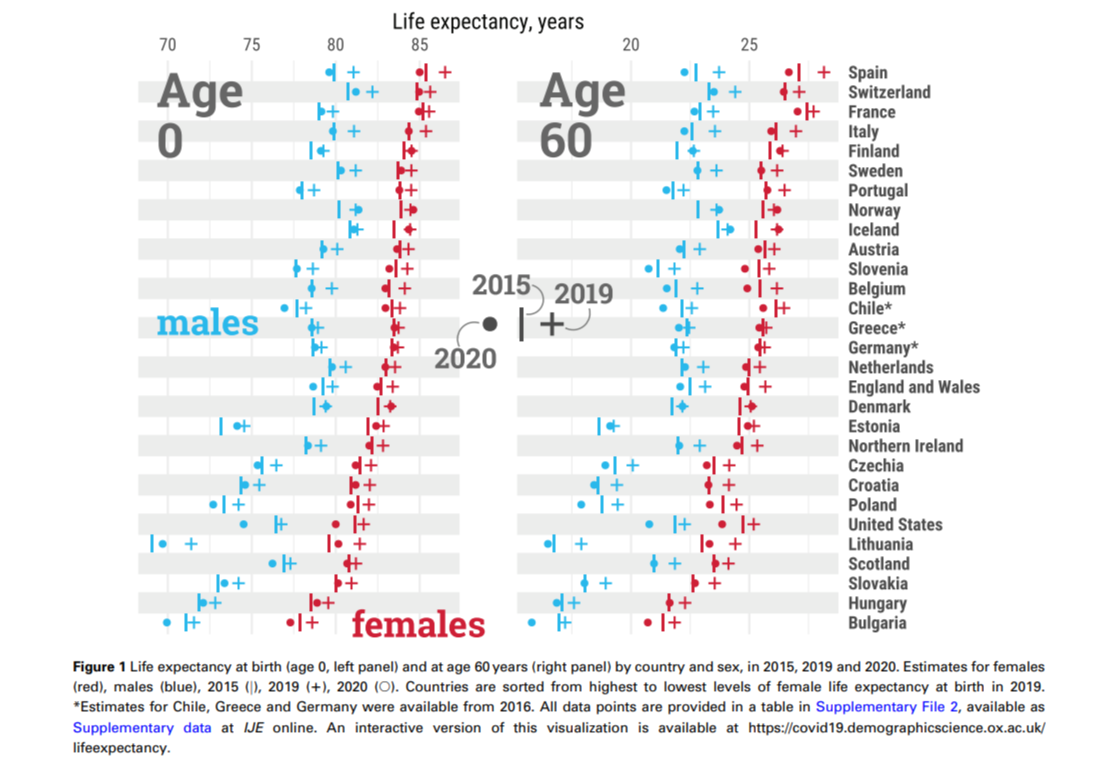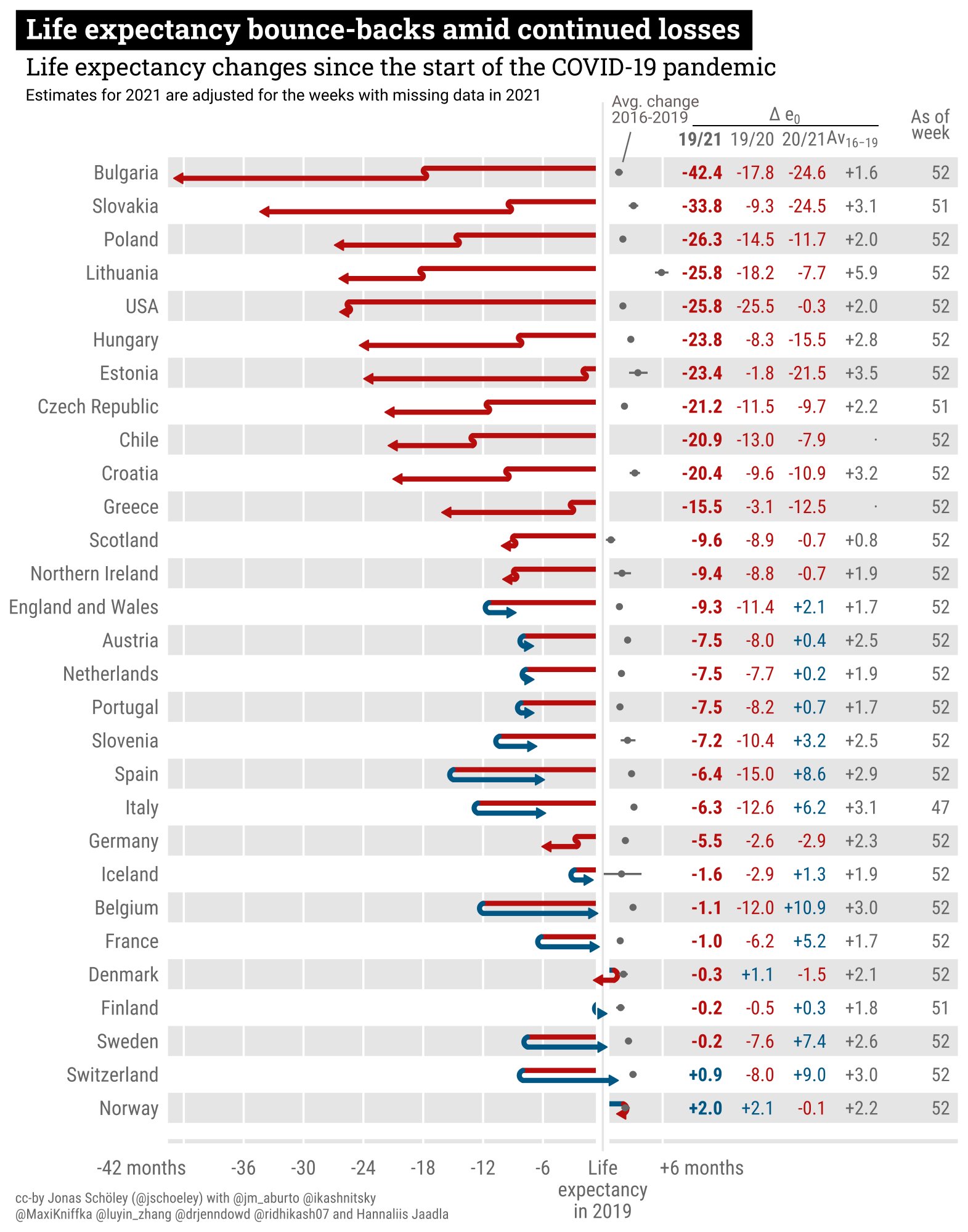What is life expectancy?
It is a misleading term that does not refer to the years a cohort of newborns is expected to live. Nor is it a direct observation. It is, in fact, a 'snapshot' of current mortality obtained from mathematical models. It is therefore constantly changing and can worsen when catastrophes such as wars and pandemics occur.
One way to understand life expectancy is to compare it to the kilometres the car tells us we can drive with the remaining petrol: if we drive up a steep hill, the distance will decrease; if we drive down a hill, it will increase. The covid-19 pandemic has been an extremely steep slope for many countries, especially in 2020.
How much has it gone down because of the pandemic?
The covid-19 pandemic has meant falls in life expectancy unprecedented in recent history, with mortality not seen since the Second World War. In the case of Spain, 2020 ended with the highest number of deaths and lowest number of births since records began after the Civil War in 1941.
A recently published study estimated that life expectancy in the United States fell by an average of 1.87 years of life between 2019 and 2020, the largest decline in the 21 rich countries analysed. Spain was second on the list, with a drop of 1.43 years, followed by England/Wales with 1.38 years. The average loss was 0.58 years. In countries such as New Zealand and Taiwan life expectancy increased, and in others such as Denmark, Norway, Finland and South Korea it did not change.
These data are the most recent, but they are not unique. "The paper builds on what has already been published during the pandemic and does not differ in its results from those already published," explains Diego Ramiro, Director of the CSIC's Institute of Economics, Geography and Demography.
"The differences in life expectancy loss between Hispanics, African-Americans and the rest of the population in the United States had already been shown during the pandemic. This work highlights the relevant issue of health inequalities between population groups in the USA, and how these inequalities accentuate the gap in life expectancy with other advanced countries," Ramiro adds.

How long will it take to recover?
If we resort again to the metaphor of the car and gasoline, we can understand that life expectancy will approach pre-pandemic estimates as we finish climbing the slope. Vaccines, treatments, population immunity gained through infections and better understanding of the virus have already made the slope much less steep.
That is why the above data refer to the change between 2019 and 2020. While in some countries such as the United States the decline continued in 2021, others such as Spain managed to start their recovery. "This heterogeneity observed in 2021 indicates that the path to long-term recovery of lost life expectancy remains unclear," wrote the authors of a prepublication analysing these changes.
Adding to this uncertainty is the fact that pandemics do not end abruptly, if at all. Experience from previous crises such as the 1918 influenza shows that excess deaths continue into the following years, even if society turns the page.
For covid-19, a spiral model has been proposed whereby successive epidemic waves would have a diminishing, but still existing, impact. However, there are still many doubts about how a still pandemic SARS-CoV-2 will behave, far from the seasonality and endemism it is likely to reach one day.

Why are there so many differences between countries and regions?
One of the big questions in the pandemic is why the coronavirus has had a different impact across countries and regions, sometimes in a seemingly counter-intuitive way.
The answer is complex because it is difficult to compare countries with each other, especially if they come from different backgrounds. The list of factors that play a role in the final outcome is long, and not all of them are controllable by humans.
Connectivity and geographic density, population demographics (such as health status and ageing), economics and levels of inequality, climate, quality of the health and residential system, measures and policies employed against the coronavirus, access to treatment and vaccination coverage are some of them.
Following Covid-19, there has been a significant drop in life expectancy in the EU.
— Xavi Ruiz (@xruiztru) April 30, 2022
Hardest hit regions: Madrid (-3,5), Lombardia (-2,8) and Castilla la Mancha (-2,8). pic.twitter.com/2RjDA0JFGF
Do we know how many people died from covid-19?
Knowing how many people have died as a result of the pandemic is not as easy as looking at the figures shared by countries. The definition of what counts as a covid-19 death is not universal. Moreover, some countries do not have good registration systems in place or were overwhelmed throughout the pandemic. Others are not noted for the transparency of their data.
To estimate the true toll of the coronavirus, several research groups have attempted to calculate excess deaths: how many more people died during the pandemic than would have been expected in previous years. These estimates are based on mathematical models and are not without uncertainty and criticism.
The WHO is the latest organisation to share its estimates, which are close to 15 million deaths between 2020 and 2021. This figure includes both direct deaths caused by covid-19 and indirect deaths, those that have occurred for other reasons, for example, due to the saturation of health systems. Other studies have produced similar or higher figures: 18 million according to the Institute for Health Metrics and Evaluation and more than 20 million according to The Economist.
However, all these estimates have been criticised for their methodology. For example, for extrapolating data from developed countries to those without registries. They have also been criticised for providing unrealistic data for some places. We may never know exactly how many people died from the pandemic during the hardest years, only that the figure is much higher than the official one.




